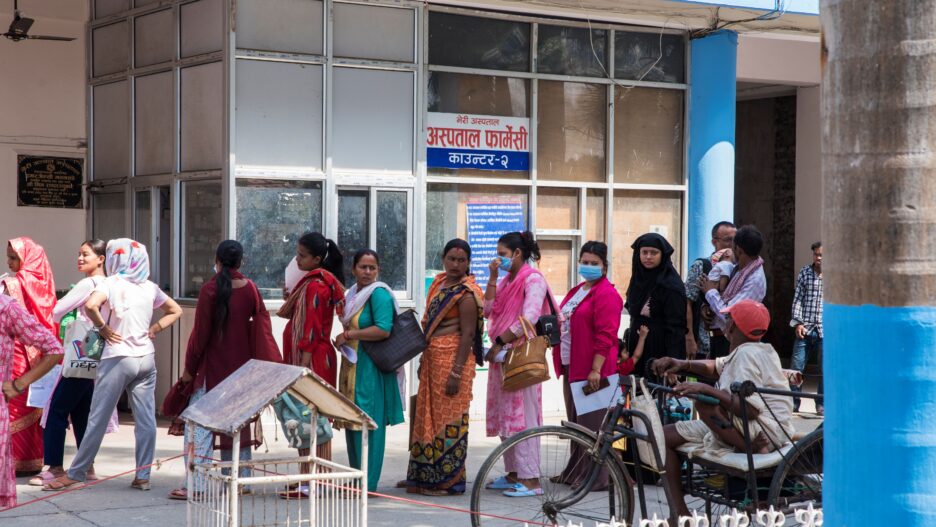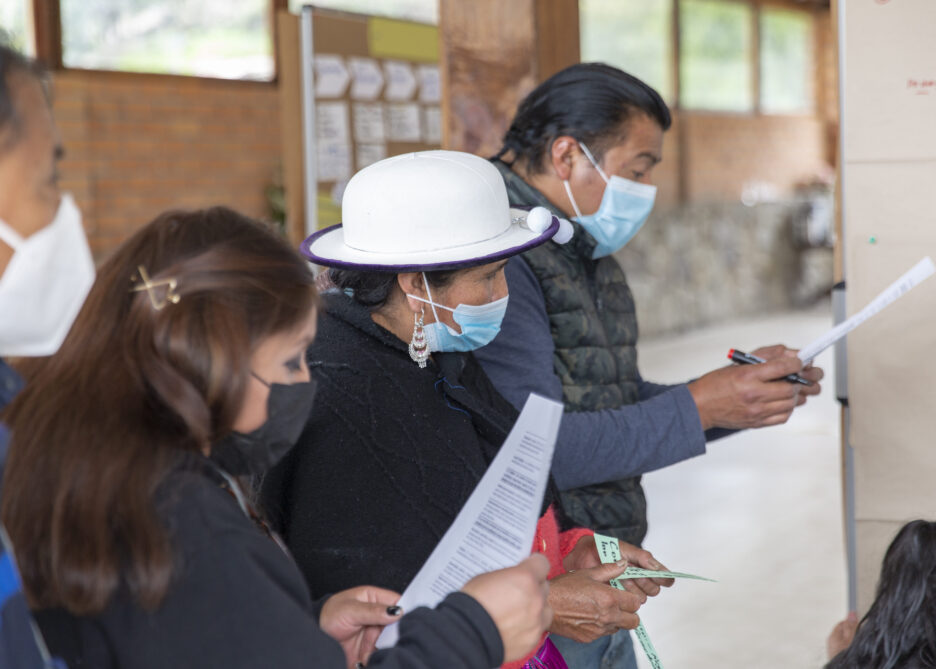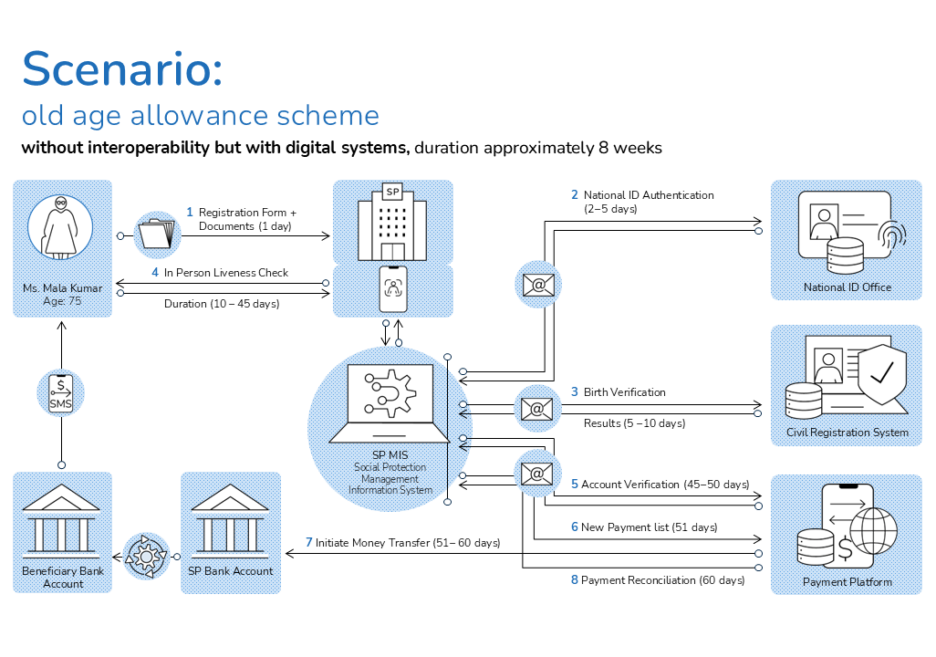Interoperability: a key to scalable and sustainable social protection

A farmer’s application for emergency drought assistance is delayed because his name is spelled differently on his land title and his identity document. An elderly widow waits in long lines at three different offices to collect documents required for enrollment in a social pension scheme. A student with a disability loses out on a supplement to her scholarship because the education authorities cannot verify her disability status, which was issued in another province.
Scenarios such as these unfortunately remain all too common, and highlight a problem many countries face in the delivery of social protection: the lack of digital interoperability. When information systems holding vital information cannot communicate, people applying for services face unnecessary paperwork, slow processing times, and errors which can lead to exclusion from benefits. These inefficiencies disproportionately affect the most vulnerable – persons with disabilities, older persons, residents of remote areas, and individuals who are not literate – and undermine efforts to ensure that all people, everywhere, have access to social protection.
What is interoperability and why does it matter?
Interoperability refers to the ability of information systems that operate independently of one another to exchange data seamlessly when authorized to do so. When systems are interoperable, they can ‘speak’ to each other by sharing, processing and using each other’s data. In the context of social protection, interoperability allows ministries, government agencies, and service providers to verify beneficiary information, screen applicants for eligibility and enroll them in schemes, issue and track payments and other social services, and monitor the implementation of programs in a coordinated way.
Despite the growing use of digital tools in social protection, many countries still struggle with information systems that do not share data. This holds back digital social protection from realizing its full promise.
From fragmentation to interoperable systems
Interoperability is largely about overcoming fragmentation. In many countries, vital information sits in siloes, from civil registration systems and social registries, to the health and education systems, labour and employment databases, and financial institutions. Information about the same individuals is often collected and held in different formats by different entities, with varying degrees of quality and completeness.
To overcome this fragmentation and to make interoperability a reality, certain technical prerequisites must be met. Standardized protocols, data dictionary, and APIs (Application Programming Interfaces) ensure that disparate systems can work together effectively, regardless of their underlying architecture or technology.
The Digital Convergence Initiative works to strengthen these building blocks. It facilitates the development and endorsement of technical standards through a consensus-based consultative process and then supports countries to implement these within their digital social protection systems to promote interoperability and integration of systems.

Interoperability enhances efficiency
Interoperable systems significantly reduce the time and cost involved in delivering social protection. Because data can be exchanged, including in real time, the multiple administrative steps needed to process applications or transactions can be compressed into shorter timeframes. Waiting times for applicants are shortened or even eliminated, as decisions can be taken faster and benefits disbursed more quickly. This is particularly important in times of crisis, when people require rapid assistance.
Moreover, these systems cut costs by eliminating the need to collect and input the same information into multiple, separately maintained systems. This saves time, money and administrative efforts, freeing up more resources for beneficiaries. It also improves data accuracy. When systems pull data directly from verified sources, such as national ID databases or civil registries, there is less room for error. Eligibility assessments are more reliable, and the chances of fraud or abuse are limited.
More accessible and inclusive social protection
Interoperable systems make vital services more accessible, particularly for hard-to-reach groups. For instance, people in remote areas can register for social protection services through digital portals and receive benefits through digital payment platforms. Interoperability also fosters inclusion, by making it possible to identify beneficiaries who might otherwise remain invisible to the social protection system. Information about smallholder farmers, for example, may be available in information systems managed by ministries of agriculture, but not in the social registries used to administer cash transfers to poor households living primarily in urban areas. Once they are made interoperable, these two systems could be used to extend benefits to farmers living in particular areas who need assistance following a natural disaster. In such a way interoperability fosters adaptive social protection: governments can respond to crises in a nimble way by drawing upon the data and analytics made possible by interoperable systems.
Interoperable systems also make tailored and proactive services possible. With a more complete picture of each household’s circumstances – income, education, health, place of residence – social protection programs can be better targeted to meet people’s specific needs and even anticipate them, without people having to apply for services. For example, a child living in a poor household with a disabled parent might qualify for an educational scholarship, nutritional assistance, and caregiver support. Interoperability allows a more holistic understanding of beneficiaries’ individual situations and enables convergence between different types of social programs.
The basis for scalable, sustainable digital social protection
With an estimated 3.8 billion people still lacking access to social protection, the world urgently needs scalable solutions to close the social protection gap. Interoperable systems built on shared standards provide a flexible, reliable basis for expanding coverage and introducing new programs. This is especially critical during emergencies, as experiences during the COVID-19 pandemic showed.
Interoperable solutions also offer long-term sustainability. While custom-built information systems can become obsolete as technology evolves, interoperable systems built with open standards and protocols can adapt to new technologies. They provide a durable, future-proof infrastructure that governments can rely on for the delivery of public services.
Interested to learn more?
If you’d like to learn more, join the next session of our Talking Interoperability webinar series, which brings together experts from around the world to share insights, country experiences, and practical guidance.
You can also browse our past events to learn more about what interoperability looks like in action.
Author: Karen Birdsall
